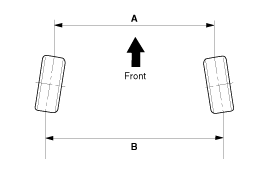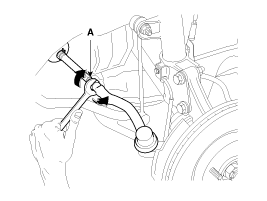 Hyundai Veloster: Alignment. Repair procedures
Hyundai Veloster 2011-2017 Service Manual / Suspension System / Tires/Wheels / Alignment. Repair procedures
Hyundai Veloster: Alignment. Repair procedures
Hyundai Veloster 2011-2017 Service Manual / Suspension System / Tires/Wheels / Alignment. Repair procedures
Front Wheel Alignment
• When using a commercially available computerized wheel alignment
equipment to inspect the front wheel alignment, always position the
vehicle on a level surface with the front wheels facing straight ahead.
• Prior to inspection, make sure that the front suspension and
steering system are in normal operating condition and that the tires
are inflated to the specified pressure.
• You have to ASP (Absolute Steering Position) calibration after
alignment adjusting.
|
Toe

B - A. 0: Toe in (+)
B - A < 0: Toe out (-)
|
Toe Adjustment
| 1. |
Loosen the tie rod end lock nut.
|
| 2. |
Remove the bellows clip to prevent the bellows from being twisted.
|
| 3. |
Adjust the toe by screwing or unscrewing the tie rod. Toe adjustment
should be made by turning the right and left tie rods by the same amount.
|
| 4. |
When completing the toe adjustment, install the bellows clip and
tighten the tie rod end lock nut to specified torque.
|
Camber and Caster
Camber angle : -0.5° ±
0.5°
|
Caster angle : 4.22° ±
0.5°
|
Rear Wheel Alignment
When using a commercially available computerized wheel alignment
equipment to inspect the rear wheel alignment, always position the vehicle
on a level surface.
Prior to inspection, make sure that the rear suspension system
is in normal operating condition and that the tires are inflated to
the specified pressure.
|
Toe

B - A. 0: Toe in (+)
B - A < 0: Toe out (-)
|
Toe:
Total : 0.5°(+0.5°/ -0.4°)
Individual : 0.25°(+0.25°/ -0.2°)
|
Camber
Camber : -1.5°±0.5°
|
 Tires/Wheels
Tires/Wheels
...
 Wheel. Repair procedures
Wheel. Repair procedures
Hub Nut Tightening Sequence
Tighten the hub nuts as follows.
Tightening torque :
88.3 ~ 107.9N.m (9.0 ~ 11.0kgf.m, 65.1 ~ 79.6lb-ft)
...
See also:
Specifications
Specification
Description
Specification
Ultrasonic sensor
Rated voltage
DC 12V
Detecting range
11.8~47.2 i ...
Multimedia Jack. Repair procedures
Removal
1.
Remove the floor console assembly.
(Refer to the BD group - "Console")
2.
Remove the multimedia jack assembly (A). ...
Knock Sensor (KS). Description and Operation
Description
Knocking is a phenomenon characterized by undesirable vibration and noise
and can cause engine damage. Knock Sensor (KS) is installed on the cylinder
block and senses engine knoc ...
Categories
- Hyundai Veloster Manuals Home
- Hyundai Veloster 2010-2017 Owner's Manual
- Hyundai Veloster 2010-2017 Service Manual

